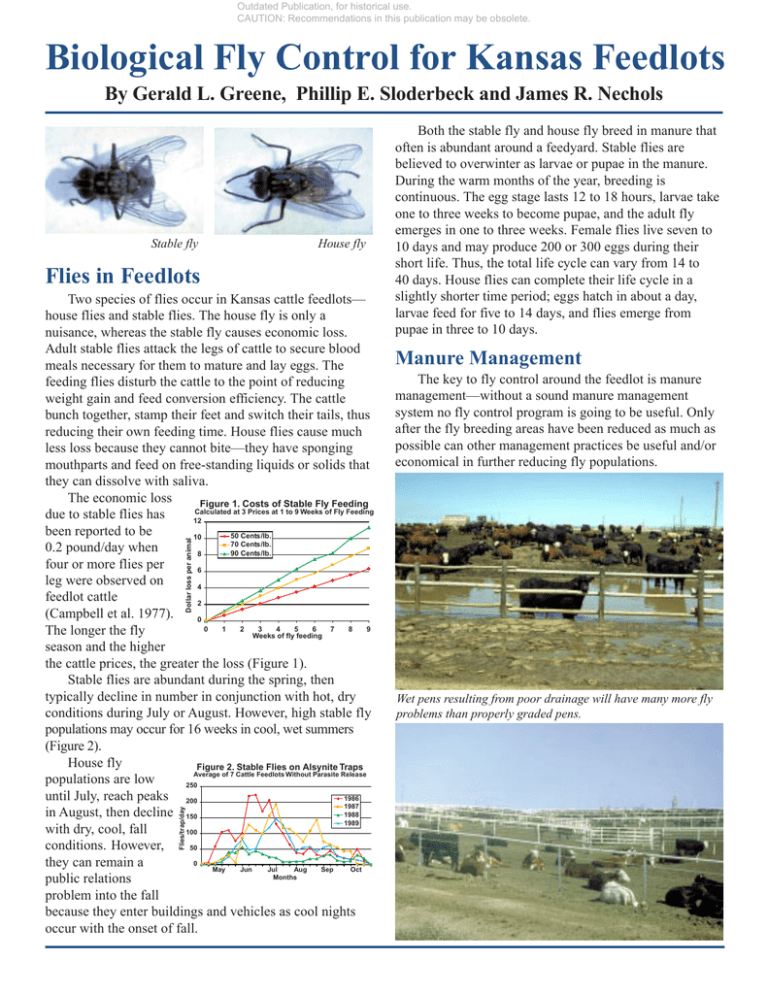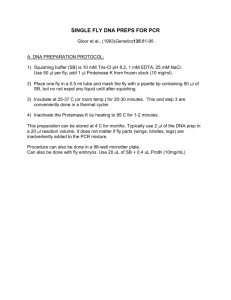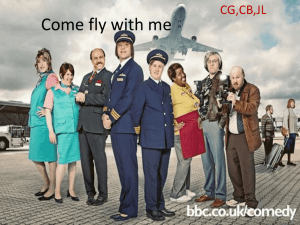
Outdated Publication, for historical use.
CAUTION: Recommendations in this publication may be obsolete.
Biological Fly Control for Kansas Feedlots
By Gerald L. Greene, Phillip E. Sloderbeck and James R. Nechols
Stable fly
House fly
Flies in Feedlots
Manure Management
The key to fly control around the feedlot is manure
management—without a sound manure management
system no fly control program is going to be useful. Only
after the fly breeding areas have been reduced as much as
possible can other management practices be useful and/or
economical in further reducing fly populations.
Flies/trap/day
Dollar loss per animal
Two species of flies occur in Kansas cattle feedlots—
house flies and stable flies. The house fly is only a
nuisance, whereas the stable fly causes economic loss.
Adult stable flies attack the legs of cattle to secure blood
meals necessary for them to mature and lay eggs. The
feeding flies disturb the cattle to the point of reducing
weight gain and feed conversion efficiency. The cattle
bunch together, stamp their feet and switch their tails, thus
reducing their own feeding time. House flies cause much
less loss because they cannot bite—they have sponging
mouthparts and feed on free-standing liquids or solids that
they can dissolve with saliva.
The economic loss
Figure 1. Costs of Stable Fly Feeding
Calculated at 3 Prices at 1 to 9 Weeks of Fly Feeding
due to stable flies has
12
been reported to be
50 Cents/lb.
10
70 Cents/lb.
0.2 pound/day when
90 Cents/lb.
8
four or more flies per
6
leg were observed on
4
feedlot cattle
2
(Campbell et al. 1977).
0
0
1
2
3
4
5
6
7
8
9
The longer the fly
Weeks of fly feeding
season and the higher
the cattle prices, the greater the loss (Figure 1).
Stable flies are abundant during the spring, then
typically decline in number in conjunction with hot, dry
conditions during July or August. However, high stable fly
populations may occur for 16 weeks in cool, wet summers
(Figure 2).
House fly
Figure 2. Stable Flies on Alsynite Traps
Average of 7 Cattle Feedlots Without Parasite Release
populations are low
250
until July, reach peaks 200
1986
1987
in August, then decline 150
1988
1989
with dry, cool, fall
100
conditions. However,
50
0
they can remain a
May
Jun
Jul
Aug
Sep
Oct
Months
public relations
problem into the fall
because they enter buildings and vehicles as cool nights
occur with the onset of fall.
Both the stable fly and house fly breed in manure that
often is abundant around a feedyard. Stable flies are
believed to overwinter as larvae or pupae in the manure.
During the warm months of the year, breeding is
continuous. The egg stage lasts 12 to 18 hours, larvae take
one to three weeks to become pupae, and the adult fly
emerges in one to three weeks. Female flies live seven to
10 days and may produce 200 or 300 eggs during their
short life. Thus, the total life cycle can vary from 14 to
40 days. House flies can complete their life cycle in a
slightly shorter time period; eggs hatch in about a day,
larvae feed for five to 14 days, and flies emerge from
pupae in three to 10 days.
Wet pens resulting from poor drainage will have many more fly
problems than properly graded pens.
Outdated Publication, for historical use.
CAUTION: Recommendations in this publication may be obsolete.
2
Steps to Reducing Fly Numbers
1. Keep undisturbed manure as dry as possible. Manure
inside pens is constantly being stirred and trampled, so
regardless of how wet it is, flies cannot breed there.
However, manure that is undisturbed, like along feed
bunks, under fences, around waterers, and between
pens and alleyways provides ideal fly breeding areas.
Keep waterers in good repair to avoid leaks, and grade
lots and alleyways to provide good drainage.
2. Scrape empty pens, alleyways, and fencelines to
remove as much manure as possible and to improve
drainage.
3. Clean up spilled feed, decaying hay and silage.
4. Control weeds to remove fly resting areas.
BIOLOGICAL FLY CONTROL FOR KANSAS FEEDLOTS
mating and searching for more fly pupae. The adult
parasite lives about seven to 10 days.
Fly parasites are obligate parasites of flies—they
cannot live without flies. When fly parasites are
introduced into manure and other breeding sites, the only
way they can survive is to find and lay their eggs in fly
pupae. When enough fly parasites are released into an
area, the fly population can be dramatically reduced. This
is the basic principle of biological fly control. Fly
parasites need to be added to the breeding sites in
sufficient numbers to inflict heavy damage on the fly’s
ability to survive and reproduce. This does not mean that
by releasing a large number of fly parasites at one time
Manure and weeds around pens provide excellent fly habitat and
need to be controlled to reduce fly numbers as part of a total fly
management program.
Adult fly
Fly eggs
Going the Next Step
Once a good manure management system is in place,
the feedlot manager is ready to take the next step and
consider releasing parasites to help reduce the number of
flies emerging from fly breeding sites that cannot be
eliminated.
Maggot or
larvae
Adult parasite
emerges
Pupae with young
fly inside
Parasite Biology
The parasitic wasps used in fly control programs kill
flies to provide a place for their larvae to develop.
Females search through manure to find fly pupae. When a
female parasite finds a pupa she will insert her ovipositor
into the pupa and lay an egg. Some of the fly pupae will
die from the sting alone (up to 30 percent); most will be
consumed by the parasite larva that hatches from the egg
laid inside the fly pupa. Each female will lay 20 to 45
eggs. Eggs hatch in about two days, larvae feed for seven
to nine days, and the parasite pupal stage lasts seven to
nine days. The adult parasites then emerge by cutting a
hole in the fly pupal case and start the cycle over again by
Pupae with young
parasite inside
Parasite stings,
kills developing
fly and lays egg
they will eliminate the flies for that season. Fly parasites
reproduce very slowly compared to flies. House flies can
turn over an entire generation in less than 10 days and
each generation can live approximately 30 days. Fly
parasites, on the other hand, take about three weeks to
produce a generation. Multiple releases are required to
Outdated Publication, for historical use.
CAUTION: Recommendations in this publication may be obsolete.
3
BIOLOGICAL FLY CONTROL FOR KANSAS FEEDLOTS
Selecting the Right Parasite
The first attempts at releasing parasites to control flies
in Kansas feedlots relied on parasites not native to the area
and results were questionable. Recent research has
centered on determining which species of parasites are
native to the area in an attempt to improve the
effectiveness of future releases.
Spalangia endius and Nasonia vitripennis have been
sold and released in feedlots but are seldom retrieved from
fly pupae. This demonstrates that these species have not
established in Kansas feedlot environments and probably
are not adapted to the conditions.
The two main groups of pupal parasites occurring
naturally in Kansas cattle feedlots are Spalangia and
Muscidifurax. In the genus Spalangia, S. nigroaenea
dominates S. cameroni by about three to one. While in the
genus Muscidifurax, M. zaraptor outnumbers M. raptor by
about the same ratio.
Muscidifurax zaraptor is predominantly collected
from house fly pupae, suggesting this parasite might be
the species of choice for house fly control and it is
probably the most common of commercial parasites sold
because it is easy to rear. However, since it is only
occasionally found in stable fly pupae it should not be the
sole species used for a feedlot fly control program.
Spalangia nigroaenea appears to be well adapted to
the feedlot environment of Kansas. It is commonly found
in both stable fly and house fly pupae and is the most
common parasite found in stable fly pupae in Kansas.
Thus, S. nigroaenea appears to be the appropriate parasite
species for stable fly control in Kansas feedlots.
Quality Control is Important
Selecting the right insectary for providing the parasites
is a very important decision. Two important considerations
are viability of the parasites and purity of the sample.
Commercially produced fly parasites arrive at the
feedlot inside parasitized house fly pupae. Parasite
emergence from pupae must occur if releases are to
effectively reduce fly numbers. Emergence has never been
high, averaging 50 to 60 percent from the best material we
have sampled. This is an area where further improvement
is needed.
The other recurring problem is contamination. Only the
desired species of parasites should emerge from parasitized
fly pupae delivered to the feedlot. Too often, less than 80
percent of the emerging parasites are species adapted to
Kansas cattle feedlots. Commercial insectaries rearing
several species of parasites have difficulty rearing pure fly
parasite colonies, because the parasite species adapted to
cattle feedlots are not very competitive and their colonies
often become contaminated by other species of parasites.
In the future there may be a service or regulatory
program to reduce these problems. For now, a producer
should find a reputable supplier that understands the feedlot
fly problem, and check to ensure the shipments are viable
when they arrive for release. However, most producers will
not be able to determine the actual species being released
and, thus, must rely on the reputation of the dealer.
When to Get Started
Timing the first parasite releases in the spring is
critical to a successful fly management program. Fly
parasites are a long-term solution to fly problems, not a
Figure 4. Insectary Parasite Purity
Percent of Pupae Where the Species Claimed Actually Emerged
Divided by the Percent of Pupae Producing Parasites
100
80
60
40
20
Percent
keep sufficient numbers of fly parasites in the manure to
stop flies from simply out-breeding them.
Periodic releases should continue through the entire
fly season to ensure plenty of fly parasites are available to
control flies. Remember, the idea is not to balance nature,
but to have enough fly parasites present to keep fly
populations as low as practical.
When people learn about fly parasites it is sometimes
difficult for them to understand how these wasps work.
Some people picture large, stinging wasps swooping down
and knocking flies out of the air or carrying them off for
dinner; some have a fear that the parasites will decide to
sting people or cows instead of flies!
Fly parasites are very small—about the size of a gnat
or a small ant. Parasites cannot bite or sting a human; they
are only concerned with finding the pupal or cocoon stage
of the fly. They must use this stage to feed themselves and
for the development of their offspring. They are so
dependent on this stage of the fly, we must raise flies in
order to raise the parasites for shipment.
Fly parasites can fly, but not very well. Their wings
are used primarily to flit from place-to-place on the
manure. They cannot attack the adult fly, therefore,
parasites cannot directly reduce fly numbers. Instead, they
work in the manure killing fly pupae before they reach the
adult fly stage.
A
B
C
D
Producer
Species
Claimed %
Emerged %
Purity %
Outdated Publication, for historical use.
CAUTION: Recommendations in this publication may be obsolete.
4
BIOLOGICAL FLY CONTROL FOR KANSAS FEEDLOTS
quick fix. They take time to establish, so don’t wait until
you’re overrun with flies to start releasing parasites.
Parasite releases should start when the stable flies are
noticed bothering horses or cattle. In Kansas, stable fly
problems begin about the first of June.
Determining the Number of Parasites
to Release
Ideally, the number of parasites to release would
depend on the number of fly pupae being found. However,
more work needs to be done to develop better scouting
methods before this will be practical. For now, most
people rely on making releases based on the number of
animals present in the feedlot, with 20 to 50 parasites per
animal in the feedlot being released each week.
Where and How to Release Parasites
We have already talked about a few of the places
where flies breed. These also are excellent places to
release the parasites. Other areas to put fly parasites would
include exposed hay and silage. Flies, especially stable
flies, breed in decaying organic matter as well as manure.
It is not necessary to put fly parasites on every square
inch of breeding site. The fly parasites have wings and can
migrate short distances. Since you will receive shipments
weekly, it is a good idea to put them in different areas each
week. Be careful to avoid placing parasites where animals
will walk on them, or in areas that may be cleaned during
manure removal.
Remember, these are living insects. Even though they
are shipped in an easy to handle, immature stage, they
must be put where they will survive long enough to hatch
and go to work—avoid direct sun, pooled water, and
pesticide treated areas. The parasites should be covered
with a small amount of soil or manure to protect them
from the sun.
Integration of Parasites and Pesticides
An appropriate use for chemicals is to knock down
existing flies before you begin releases of fly parasites.
Some also can be useful as residual treatments on
buildings and nearby windbreaks.
Chemicals, however, have their limitations. Unless you
hire a licensed commercial applicator, or you are certified
as a private applicator, you cannot apply restricted use
pesticides. The chemicals must be mixed properly, stored
properly, and proper protective gear must be worn.
If the same chemical is used repetitively over a long
period of time, flies become resistant. Put simply,
susceptible flies are killed and the surviving flies pass
their resistance on to their offspring. Switching to new
chemicals doesn’t always work because sometimes the
mechanism that allows flies to be resistant to one chemical
also makes them resistant to other chemicals. Thus, using
good manure management and biological control agents
can help prolong the effective life of chemical controls.
References Cited:
Campbell, White, Wright, Crookshank and
Clanton. 1977. Effects of stable flies on weight gains and
feed efficiency of calves on growing or finishing rations.
J. Econ. Entomol. 70(5):592–594.
Acknowledgements
Funding for this publication was provided by a grant
from the National Biological Control Institute. The
authors would like to thank Jerome Hogsette, Jr., USDA
Gainesville, Florida and Don Mock, Kansas State
University, for reviewing an earlier version of this
document. We also express appreciation to Anna Barrett
and Bob Holcombe, Department of Communications,
Kansas State University, for their help with editing and
designing the document. We also thank Dave Mandeville,
University of California, Riverside, for use of the slide of
the fly parasite.
Gerald L. Greene, Retired Professor and Livestock Entomologist, Southwest Research Center; Phillip E. Sloderbeck,
Professor and Extension Specialist, Entomology, Southwest Area Extension Center; James R. Nechols, Professor,
Research and Teaching, Entomology, Manhattan
Brand names appearing in this publication are for product identification purposes only. No endorsement is intended,
nor is criticism implied of similar products not mentioned.
Publications from Kansas State University are available on the World Wide Web at: http://www.oznet.ksu.edu
Contents of this publication may be freely reproduced for educational purposes. All other rights reserved. In each case, credit Gerald Greene, Phillip
Sloderbeck, James Nechols, Biological Fly Control for Kansas Feedlots, Kansas State University, April 1998.
Kansas State University Agricultural Experiment Station and Cooperative Extension Service
MF 2223 (Revised)
April 1998
It is the policy of Kansas State University Agricultural Experiment Station and Cooperative Extension Service that all persons shall have equal opportunity and
access to its educational programs, services, activities, and materials without regard to race, color, religion, national origin, sex, age or disability. Kansas State
University is an equal opportunity organization. Issued in furtherance of Cooperative Extension Work, Acts of May 8 and June 30, 1914, as amended. Kansas State
University, County Extension Councils, Extension Districts, and United States Department of Agriculture Cooperating, Marc A. Johnson, Director.
File code: Entomology—2
AB4-98—400








